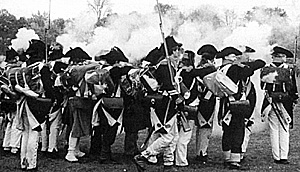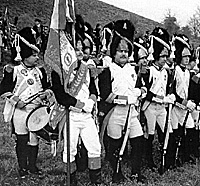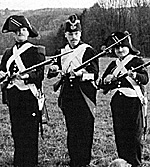Based in Jena, the 19eme Ligne represents the regiment at the time of the battle in 1806. The group was founded by three enthusiasts from Jena in 1981 in Leipzig as part of the DDR government-supervised umbrella group 'Interessensgemeinschaft Volkerschlacht Leipzig 1813', whose main purpose was the annual October commemoration of Leipzig, in which groups from both sides of the East-West divide participated.
Even at that early stage, events on foreign battlefields were included in the group's programme. The three founders of the unit were soon involved with preserving the Leipzig battlefield during their free time, notably the restoration of the monument on the Sperlingsberg near Kappellendorf. As well as this, they became involved in local efforts to commemorate the 180th anniversary of Jena in October 1986. The event was such a success that in the following year, a separate group was formed at Jena.
After initial efforts to represent French musicians and cuirassiers, the group opted in 1990 to become solely a Fusilier company of the 1st Battalion of the French 18th Line Infantry in 1806 uniforms, the overall association being known as the Arbeitsgemeinschaft'Jena 1806', which joined the NG in 1991.
The unit now comprises: 1 sergeant (Sargent), 1 Corporal (Caporal), 1 Standardbearer (Porte-aigle), 2 Pioneers (Sappeur), 7 Fusiliers, 2 Drummers (Tambour) and 2 Cantiniere.
The unit seeks to represent the life of the ordinary solider at all events, particularly in authentic camps demonstrating cooking, drinking, sleeping etc. In their home area, the group is involved with the preservation of old monuments and erection of new ones at Jena. Twelve of the new stones have been placed at important points on the battlefield with a further five planned, which all show the names of the units in that area, their commanders, strength and the relevant time, line of attack, etc.
The original 18eme Ligne was formed in Albenga, Itaiy in 7th March 1796 as the 18eme Demi-Brigade from the 96eme and 211eme Demi-Brigade, the 5eme and 6th Provisional Demi-Brigade, together with the 3eme Battaillon of the 45eme Demi-Brigade and the 1er Bataillion of the Paris Grenadiers, later joined by soldiers from the old Aquitain Infantry Regiment. On 14th January 1797, they pursued an Austrian regiment for 10 hours and marched on through Garde to take part at Rivoli. In 1798, a bataillon fought at Alexandria and participated in the Egyptian campaign.
The unit received its new title of 18eme Regiment in September 1803 and fought in the 1805 campaign as part of the 3rd Division of Soult's IV Korpa through Bavaria and at Austerlitz on 2nd December. Continuing as part of La Grande Armee, the 18eme fought at Jena in 1807 and at Eylau on 8th February 1807, finishing the campaign at Heilsberg on 10th June 1807.
As part of Ledru's brigade (Massena's Corps) in 1809, three battalions stormed the gate of Ebelsberg castle on 3rd May - the 4th battalion was part of Lannes' Corps - and the regiment fought in the summer battles at Aspern and Wagram.
On 24th June 1812, the 18eme as part of Ney's III Corps crossed the Niemen into Russia, marching to fight at Smolemsk and Borodino. In the dreadful retreat, the regiment lost its eagle on 17th November. Reformed for the 1813 campaign as part of Victor's II corps, the 18eme fought in the major battles of that year at Dresden, Leipzig and Hanau.
During the following year, they fought at La Rothiere and victoriously and Montereau on 18th February. During the Hundred Days, the regiment was part of the Army of Alsace, distinguishing itself at Suerbourg and Strassbourg. (Contact: Rolf Graf, Dobereiner Strasse 12 07745 Jena)
 One of the most interesting units in
Germany is the Western 177eme DemiBrigade
(formerly Volontaires), which was formed in
1987 from members of two existing units, who
were interested in being as authentic as
possible in representing their unit in its
uniforms, equipment and drill.
One of the most interesting units in
Germany is the Western 177eme DemiBrigade
(formerly Volontaires), which was formed in
1987 from members of two existing units, who
were interested in being as authentic as
possible in representing their unit in its
uniforms, equipment and drill.
Their principal aim has been from the start to represent the changes in the Grenadier company of this unit throughout the bicentennial period and display it correctly 200 years on as the years pass
Drawing almost 40 members from Great Britain, Germany and Italy, the unit currently comprises Grenadiers, together with a Battalion artillery piece, while the ladies represent Vivandieres and Blanchiseuses (washerwomen). Major highlights so far have been participating in events celebrating the 200th anniversaries of the Storming of the Bastille, the '92 Moselle March and the Cannonade of Valmy.
The drill is conducted according to the 1st August 1791 manual and naturally given in French. However, experiencing the life of the original troops is not limited to reproducing uniforms and drill as exactly as possible, but extends to communal cooking based on original recipes, off-duty activities with contemporary games and singing songs of the Revolutionary period, sleeping in recreated French military tents on straw and conducting sentry duties to try to produce the entire military experience, albeit in an enjoyable way.
The priority in recreating uniforms is to use authentic materials, including for example, buttons and buckles cast from originals. Cartridge boxes are bought up to a shine with black wax made from a 200 year old recipe.(4) Because cigarettes were unknown in France at the time, smokers in the unit are assisted in acquiring clay pipes for use at events.
Similarly, those who do wish to grow their hair long can wear a fake ponytail. Although moustaches are favoured for the Grenadiers, beards are not permitted.
The original unit was formed in Cernay near Calmar in Alsace on 1st October 1791 as tier Bataillon des Gardes Nationales Volontaires du Haut-Rhin'. On 1st May 1794 (12 Floreal Year 2), it was combined with the 99eme Ligne to form the 177eme Demi- brigade, the unit becoming the 2nd Bataillon.
The next change took place on 1st March 1796 (1 Ventose Year 4) (likewise 1996), when the 177eme were combined with the 59eme Demi-brigade to form the 102eme Demibrigade de Ligne.
As the uniforms didn't undergo major changes in the period 1791-1801, the costs of joining this unit are no greater than others. New members can also be loaned kit. (Contact: Hans-Karl Weiss, MemmelsdorferStrasse 102, 96052 Bamberg)
Imperial Guard
 Two groups represent Imperial Guard
units. The Grenadier a Pied de la Garde
Imperiale, based in Finsterwalde, were
originally formed on 10th May 1984 as the 'Befreiungskriege 1813 Finsterwalde' again under the compulsory auspices of the DDR Culture Ministry.
Two groups represent Imperial Guard
units. The Grenadier a Pied de la Garde
Imperiale, based in Finsterwalde, were
originally formed on 10th May 1984 as the 'Befreiungskriege 1813 Finsterwalde' again under the compulsory auspices of the DDR Culture Ministry.
The original aims of the group were based on living the life of the French troops and from small beginnings, the group expanded to include both men and women as its existence soon became known outside the old East Germany. In 1992, the group joined the NG and became 'Traditionscorps 1813 Finsterwalde, Kaisergarde N.1. Grenadiere zu Fuss, 1. Btl, 1. Regiment', which now stands at 25 members. It is involved in events both in Germany and outside, notably the Waterloo re-enactments.
The main aim is now to field a platoon of Old Guard Grenadiers in recreated authentic uniforms and equipment, working continuously to improve its appearance and drill, which is conducted according to the 1791 regulations. Currently, the unit stands at: 1 Officer, 1 Sergeant-Major, 1 Sergeant, 1 Drummer, 1 Ensign (Porte-aigle) and 8 Grenadiers. (Contact: Hans Michael Hillebrand, Brandenberg Strasse 53, 03238 Finsterwalde).
 The Western Guard unit, 1er Regiment des Chasseurs a Pied de la Garde Imperiale is based in
Cologne, which from 1794 to 1814 was under French control and was part of the Department de la Roer. Napoleon visited the city in 1804 and 1811, presented a gift of 12,000 Francs, placed it on the list of 'Bonnes Villes' and permitted the city to include the Imperial bees in
its arms.
The Western Guard unit, 1er Regiment des Chasseurs a Pied de la Garde Imperiale is based in
Cologne, which from 1794 to 1814 was under French control and was part of the Department de la Roer. Napoleon visited the city in 1804 and 1811, presented a gift of 12,000 Francs, placed it on the list of 'Bonnes Villes' and permitted the city to include the Imperial bees in
its arms.
The original unit was formed pursuant to a Decree dated 29th July 1804 as a regiment of Chasseurs incorporated into the Guard. Two years later in 1806, the Guard was expanded and reorganised to include two regiments of Chasseurs a Pied and one of Velites.
Naturally, this group chose a French unit close to the French Emperor and aspires to an accurate representation of these elite troops. Orders are given in French in accordance with the 1791 regulations. Each new member is first a Velite, whilst he is gradually acquiring his kit, so that when it and his drill are up to standard, he can become a Chasseur.
1994 was a busy year including foreign events at Boulogne and Le Quesnoi. In co-operation with Cologne City Museum, the group organised an event commemorating the 200th anniversary of the arrival of French troops in the city. Working with the museunr staff has continued ever since. (Contact: Hans-Joachinr Baedermann, Am Heiligenhauschen 11, 51145 Koln).
More Waterloo
Back to Age of Napoleon No. 22 Table of Contents
Back to Age of Napoleon List of Issues
Back to MagWeb Master List of Magazines
© Copyright 1996 by Partizan Press.
This article appears in MagWeb (Magazine Web) on the Internet World Wide Web.
Other military history articles and gaming articles are available at http://www.magweb.com